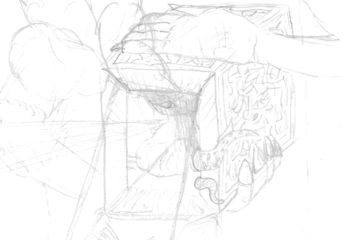The Ironwood Chisel is a legendary magic item. It has some interesting properties that could make it very valuable in the hands of one character and dangerous in the hands of another.
This is the first time that I am trying to put something I made up for our home game into writing. While it worked more simply than outlined here for us, I wanted to give it a little more depth here. I would love to hear your feedback, so don’t hesitate and let me know what you think!
As the other Dwarves left the mine shaft, Soren checked the instruments she had set up. For the third time. She was sure that some of the old timers would compliment her on her work, if only they could bring themselves to admit it. But in truth, she had no need for any of that.
The young woman pulled out her most prized possession out of a secret pocket in the seams of her protective leather gear. Her smile widened as her fingers touched the black wooden surface of a chisel. It was as heavy as any metal one, but the grain was clearly visible. There was nothing Soren enjoyed more than using this.
The Ironwood Chisel resembles an ordinary cold chisel. It has a round shaft, long enough to be held with two hands. The tip is flat and slightly wider than the shaft. It is assumed to have been crafted from Ironwood, a rare material that looks like black wood with dull grey grain running along the length of the shaft. (It is actually not Ironwood. See “Origins” below).
What it does
Whenever the tip of the Ironwood Chisel touches rock, that rock immediately crumbles. The result is heavy enough to fall to the ground rather than produce clouds of dust, but finer than average sand. It has no immediate effect on anything else, although it can be used like a normal chisel under these circumstances.
Holding the Ironwood Chisel in two hands, she approached the end of the mine shaft. Careful not to bump into any of her other tools, she touched the wide tip against the gray rock in front of her. Where it touched, it immediately turned into dust and settled in a small but growing pile on the ground. There was no force required to move it through the stone, either, except that she had to allow the ground stone to move out of the way.
Removing stone with the Ironwood Chisel requires patience, though. When touched to stone, it creates a divet the size of the chisel head, roughly 2″/5cm wide. Using that to create an opening of 1 cubic foot (or 30 liters) will take between half an hour and an hour, depending on the stone and how the grains can leave the area.
Secondary Demolition
The ability to remove stone comes with a caveat, though. As the Ironwood Chisel grinds down stone effortlessly, it builds up a charge. This charge is roughly equal to the force required to shatter an equal amount of stone using traditional means.
In her head, the Dwarf counted up to 10, then she retracted the tool, took out a small hammer and closed her eyes and braced herself. Very carefully, Soren gave the chisel the smallest of taps on the back, just like you would an ordinary chisel. The shockwave that came out the front shook the tunnel. It sent the dust that had accumulated around her heavy leather boots out into the cavern, and would have sent her flying as well had she not braced herself. After taking a deep breath, she touched it to the stone again and continued driving the mine shaft forward.
To release that pent-up energy, the chisel needs to be tapped on the back. This will release that energy through the tip, creating a shockwave akin to a small explosion. This energy can be used for demolition work, but if it is charged too much, the damage done to the wielder will far outweigh any desired outcome.
- Using it for 10 seconds causes the burst to be bearable and generally not damaging. It will create a stiff breeze that can whirl things around in close quarters, but nothing more.
- Using it for longer than that will create an effect similar to the Thunderwave spell. The effect causes 2d8 thunder damage plus an additional 1d8 for every 10 seconds of use after the first to a maximum of 6d8). It also pushes targets 10 feet. A successful Con save (DC 16) halves the damage taken and negates the push. This also affects the wielder of the chisel, but they get advantage
on the save since they are holding it and probably bracing themselves for the effect. If they fail, they drop the chisel instead of being pushed. - Charging the Ironwood Chisel for longer than 60 seconds without discharging it causes the chisel to hum faintly with energy. If discharged in this state, the push distance is doubled.
- If the Ironwood Chisel is being charged longer than 3 minutes without releasing the stored energy, it is considered to have a dangerous buildup, see below.
The discharge mechanism can be triggered by any solid object hitting the flat end of the chisel. It can thus be automated using a simple mechanism or triggered remotely using projectiles or thrown objects (AC 17).
Dangerous Buildup
If someone is not familiar with the item and uses it over extended periods of time (more than 3 minutes), the Ironwood Chisel starts thrumming audibly in addition to vibrating. In this state of dangerous buildup it will discharge as per the normal rules if anything al all touches its rear end, no matter the material or the force behind it.
In addition to that, there is a chance that it will release the pent-up energy without external stimulus. Once the chisel has reached this state, there is a 1 in 10 chance (a 10 on a d10) of it spontaneously going off each round.
When the Ironwood Chisel is set off in a state of dangerous buildup, it will create the equivalent of the Thunderwave spell cast at level 8, thus doing 10d8 damage and forced movement is doubled to 20 ft. The same saves apply as above.
Origins
While everyone who comes in contact with the Ironwood Chisel believes it to be made from Ironwood. that is not actually the case. It does look like it was made from a very dark, very metal looking material. The grain-like texture has lead to the conclusion that it had to be the legendary material Ironwood (For the record, Ironwood is something completely different, and looks much more interesting).
At some point, near the beginning of time, when the deities were trying to figure themselves and the world around them out, they dabbled. Some of them gave blacksmithing a try. Someone had to create all those divine weapons and armors, after all. One of them, their name unrecorded (see below) accidentally hit their own digit with the hammer, and it fell into the furnace.
They managed to retrieve most of it and re-attach it. Having found their calling as the deity of healing (insert the appropriate name for your setting here), they did not care for a sliver of bone lost in the fire. Eventually, that peculiar fragment made it into the hands of mortals.
History
Whenever someone got hold of the Ironwood Chisel, there was a chance that they would discover its unique ability by accident. Which would usually lead to more accidents until they figured out its secondary properties. Throughout history, this fragment of a divine pinky would be lost, then found again, usually in the hands of “remarkable” individuals.
It could be used by an artist to create breathtaking statues and sculptures effortlessly. A more nefarious mind could use it to power contraptions, traps or weapons. Just as likely, the Ironwood Chisel might be regarded as junk and end up in someone’s attic for a couple of decades before it is discovered again.
Use in Game and Modifications
If you want to include this item in your campaign, here are a couple of things to consider.
- Do you want to use this as the solution to a particular problem? In that case, make sure that your players do not end up stuck if they try to go another way. Or make it obvious to them that they have the solution in their possession.
- Maybe there is a material that the chisel does not destroy. It could be ore in general, or a specific one. It could also be bone, given the nature of the artifact.
- Feel free to adjust the damage dealt by the chisel’s outbursts. After all, the idea is not for the group to use the chisel for a bit only to then be obliterated by it.
- A cool way to introduce this item would be for the bad guy to use it to utterly destroy an important inscription or mural to spite the characters, then being forced to leave the Ironwood Chisel behind for them to find.
- Another interesting introduction would be to have an NPC find and use it, and it suddenly goes critical while they are near.
I hope this article gives you some ideas, up to and including introducing the Ironwood Chisel to your game. Let me know what you think! And if you liked this, why not check out my how-tos and the other roleplaying inspiration! And as always, remember to Be Inspired!


